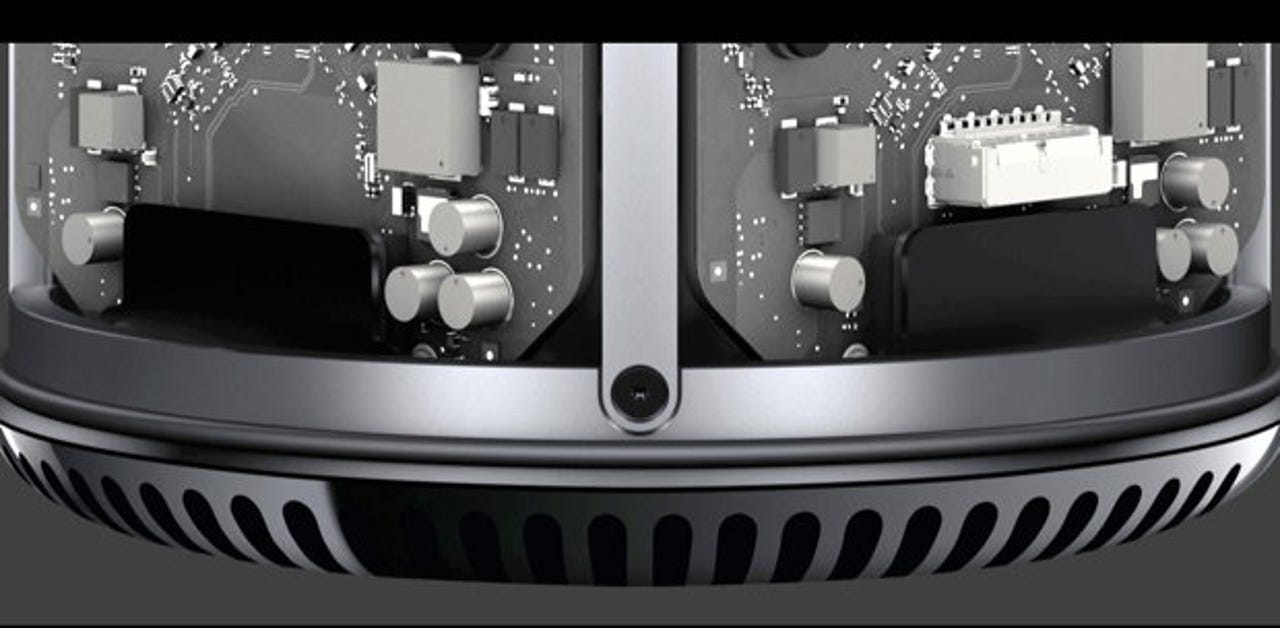First looks and teardowns of Apple's new Mac Pro

Apple CEO Tim Cook said the company would ship the new Mac Pro this year and it did so, despite many predictions that it wouldn't or couldn't. From the first-looks, I predict that the Mac Pro (Late 2013) will be the new status-symbol, C-level desktop of choice across the enterprise.

This machine is a great combination of performance power and industrial design. It will be the perfect talking-point machine for captains of industry and everyone down the food chain. It has the performance to handle 4K HDTV content, so bosses won't have to rely upon someone else's machine to view any content associated with the brand. It is expandable, although the enterprise crowd won't really need that, outside of C-level executives in engineering, architecture, sci-tech and content-creation companies.
And it has a sexy, black, sleek look. It will be a surprise hit this year, beating sales expectations.
In a review at Anandtech, Anand Lal Shimpi says he never thought that he would go back to the Mac Pro. He appreciated the flexibility offered by his 15-inch MacBook Pro as a desktop, and there was no way he was "going to take two steps back in single threaded performance just to get a quieter system." He waxed enthusiastic about the updated hardware.
All in all the new Mac Pro is a good update to its aging predecessor. Apple did a great job with the new chassis and build a desktop that's extremely dense with compute. When I had to dust off the old Mac Pros to prepare them for this comparison I quickly remembered many of the reasons that frustrated me about the platform. The old Mac Pro was big, bulky, a pain to work on and was substantially behind the consumer Macs in single threaded performance. The new Mac Pro fixes literally all of that. If you have a workload that justifies it and prefer OS X, the Mac Pro is thankfully no longer just your only solution, it's a great solution.
The picture isn't all rosy dealing with 4K/MST video, Lal Shimpi said. However, there are workarounds. He also suggests that the choice of monitors and the configuration of Thunderbolt 2 bandwidth make a great deal of difference in support for 4K performance. Thankfully, there are 6 ports available.
I measured less than 4Gbps of bandwidth (~480MB/s) available for writes to a Thunderbolt 2 device downstream from the Mac Pro if it had a 4K display plugged in to it. Read performance remained untouched since display data only flows from host to display, leaving a full 20Gbps available for reads. If you’re going to connect Thunderbolt 2 devices to the Mac Pro as well as a 4K display, you’ll want to make sure that they aren’t on the same chain.
Lal Shimpi observes that the Mac Pro line will now be given some respect. He hopes that Cupertino will push Intel to drive workstation performance in the way that it pushes its partners and suppliers for the rest of its lines.
Intel does its highest paying desktop customers a disservice by always selling them a previous generation micro architecture in exchange for more cores and PCIe lanes. In the case of the Mac Pro, especially given the lackluster OS X adoption of QuickSync and how well the Mac Pro makes use of PCIe lanes, I’m actually ok with the tradeoff. You end up with a far better platform as a result.
On the tear-down front, iFixit presented its repairability score for the new model: 8 out of 10 (10 is easiest to repair). Despite the good score, the article still advised that without a repair manual, technicians shouldn't risk working on the expensive equipment due to "some proprietary new connectors and tight cable routing."
For being so compact, the design is surprisingly modular and easy to disassemble. Non-proprietary Torx screws are used throughout, and several components can be replaced independently. The easily-opened case is designed to make RAM upgrades a snap. The fan is easy to access and replace.
While it will require a bit of digging, the CPU is user-replaceable—meaning intrepid fixers should be able to save considerably by upgrading from the base-level processor configuration.
On its blog, Other World Computing also posted a very detailed photo teardown of the new Mac Pro.
In addition, Apple recently posted a note about the memory specifications of the Mac Pro (Late 2013).